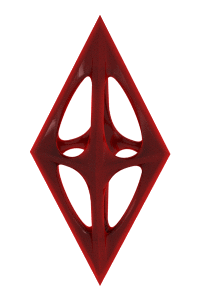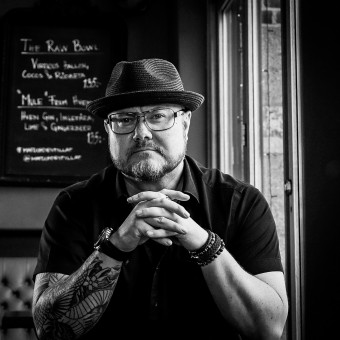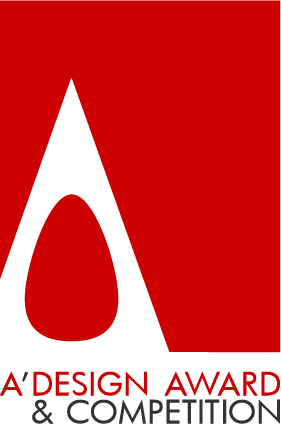
| THE AWARD |
| CATEGORIES |
| REGISTRATION |
| SUBMIT YOUR WORK |
| ENTRY INSTRUCTIONS |
| TERMS & CONDITIONS |
| PUBLICATIONS |
| DATES & FEES |
| METHODOLOGY |
| CONTACT |
| WINNERS |
| PRESS ROOM |
| GET INVOLVED |
| DESIGN PRIZE |
| DESIGN STORE |
| THE AWARD | JURY | CATEGORIES | REGISTRATION | PRESS | WINNERS | PUBLICATIONS | ENTRY INSTRUCTIONS |
Interview with Kaj Ransvi |
Home > Designer Interviews > Kaj Ransvi |
Editor Frank Scott (FS) from DesignPRWire has interviewed designer Kaj Ransvi (KR) for A’ Design Award and Competition. You can access the full profile of Kaj Ransvi by clicking here.

FS: Could you please tell us more about your art and design background? What made you become an artist/designer? Have you always wanted to be a designer?
KR: From a young age, I was fascinated by technical drawings and drawn to the unique shapes found in both products and architecture. Though I don’t have formal education in design, my passion for design and relentless curiosity have been my guiding forces. I’ve learned through experience, constantly exploring new ideas, observing the world around me, and refining my craft. This self-driven approach has shaped my journey and deepened my understanding of design, allowing me to grow both creatively and professionally.
FS: Can you tell us more about your company / design studio?
KR: I run a small design studio where I handle a wide range of projects from all around the world. Despite the studio’s size, as I am the sole designer working here, I take pride in managing every aspect of the design process personally. This hands-on approach allows me to maintain a high level of attention to detail and ensures that each project aligns with my vision and standards. Working independently also gives me the flexibility to focus on creating unique, innovative solutions that meet the specific needs of each client while fostering my passion for design.
FS: What is "design" for you?
KR: For me, design is a multifaceted concept that encompasses a vast range of elements. It can be as large as the shape of a building or as small as the intricate detail of a piece of jewelry. It spans from complex industrial products to the simple design of everyday items like a milk carton. What truly stands out is when a designer pours their soul and passion into every aspect, ensuring that the product is not only functional but also optimized for the user. Good design goes beyond aesthetics – it's about creating something that serves its purpose effectively while enriching the user's experience.
FS: What kinds of works do you like designing most?
KR: I enjoy designing and developing preexisting products, particularly with the goal of improving their functionality and making them more user-friendly. I find great satisfaction in refining designs to enhance their usability and optimizing their production processes for efficiency. Whether it’s rethinking a product’s ergonomics, simplifying its design, or incorporating more sustainable materials, I aim to make improvements that elevate the overall experience. It’s the challenge of taking something familiar and transforming it into something better that drives my passion for design.
FS: What was the first thing you designed for a company?
KR: The first thing I designed for a company was a small profile for LED strip lighting. It was a complex design, but the result was sleek, clean, and slim. The project won several awards, which was a huge milestone for me. This success inspired me to expand further into the lighting industry, leading me to design a complete system for lighting. The experience taught me the importance of combining aesthetics with functionality, and it sparked my ongoing passion for creating innovative solutions that push the boundaries of design.
FS: What is your favorite material / platform / technology?
KR: My favorite material, platform, or technology is always the one that offers the best quality and is environmentally friendly. I prioritize sustainability in my designs, seeking out materials and technologies that not only meet high standards of performance and durability but also contribute to a healthier planet. Whether it's using eco-friendly materials, sustainable manufacturing processes, or cutting-edge technologies that reduce waste, I aim to create designs that balance aesthetics with responsibility. By focusing on quality and sustainability, I ensure that my work has a positive impact on both the user and the environment.
FS: Which aspects of a design do you focus more during designing?
KR: When designing, I always focus on the details, as they are what make a product stand out and feel refined. Proportions are also a key aspect, as they play a vital role in ensuring the product is comfortable and functional for the user. Getting the balance right between aesthetics and usability is essential. Every design decision, no matter how small, contributes to the overall experience and satisfaction. I believe that thoughtful attention to detail and perfect proportions create a product that not only looks great but also feels great to use.
FS: What makes a design successful?
KR: For me, great design is about perfection in every detail—size, color, texture, and proportions all harmonizing seamlessly. It’s not just about aesthetics, but how these elements work together to create a cohesive and functional experience. When all aspects align flawlessly, the design feels effortless, balanced, and impactful, making it truly exceptional.
FS: From your point of view, what are the responsibilities of a designer for society and environment?
KR: As a designer, I believe it's crucial to consider the environment in every aspect of my work. The responsibility we have is not just to create aesthetically pleasing and functional products, but also to ensure that our designs are sustainable and have a positive impact on the planet. By choosing eco-friendly materials, reducing waste in production, and designing with longevity in mind, we contribute to a brighter, more sustainable future. Our designs should leave a legacy that enhances society and minimizes environmental harm, ensuring that the world we pass on to future generations is one that’s thriving, not depleted.
FS: How do you think the "design field" is evolving? What is the future of design?
KR: I believe the design field is evolving towards a return to products with higher quality and simpler user functions. Today, the focus is often on creating overly advanced products at the lowest possible price, but I think there will be a shift toward prioritizing craftsmanship, durability, and intuitive design. As technology continues to develop, consumers will begin to appreciate the value of products that are not only functional but also sustainable and designed with longevity in mind. The future of design will likely embrace a balance between innovation and simplicity, offering products that enhance the user experience while respecting the environment.
FS: Where does the design inspiration for your works come from? How do you feed your creativity? What are your sources of inspirations?
KR: My design inspiration comes from everything around me. It could be the shape of a car, the structure of a tree, or the way a cloud moves in the sky. Even the rhythm of a song can spark an idea for a new product. I believe life itself is a constant source of inspiration. Every day offers new details, moments, and encounters that feed my creativity. I’m constantly observing my environment, and I find that inspiration often comes unexpectedly. Whether it's nature, architecture, music, or daily experiences, these elements blend together in my mind to create fresh and innovative design ideas.
FS: How would you describe your design style? What made you explore more this style and what are the main characteristics of your style? What's your approach to design?
KR: I would describe my design style as futuristic, bold, elegant, sophisticated, smooth, with influences of rocker and hip-hop culture. However, I don't strictly work within a defined style—my design approach is more dynamic and ever-evolving. I find inspiration in contrasting elements and explore a wide range of aesthetics to reflect different emotions and stories through my work. What drives me is the challenge of creating something that feels innovative, functional, and aesthetically appealing. Each project encourages me to think outside the box and adapt my design approach to best serve its purpose while pushing boundaries. Ultimately, my goal is to produce designs that leave a lasting impression.
FS: Where do you live? Do you feel the cultural heritage of your country affects your designs? What are the pros and cons during designing as a result of living in your country?
KR: I live in Sweden, but I believe my design style is a blend of influences I've gathered from around the world. Sweden's culture and heritage have certainly shaped my approach, emphasizing minimalism, functionality, and sustainability. However, my exposure to diverse cultures enriches my creativity, allowing me to incorporate various perspectives. The pros of designing in Sweden include access to innovative design resources and a strong emphasis on quality. On the flip side, the relatively small market can sometimes limit the scale of certain projects, but it also encourages a global mindset in my work.
FS: How do you work with companies?
KR: I’m always open to exciting collaborations, whether in interior design or product design. Working with companies allows me to bring fresh perspectives to different projects, and I find the process of collaborating with other professionals both rewarding and evolving. I take pride in developing designs that meet the unique needs and challenges of each company, tailoring my approach to align with their goals while still maintaining my creative integrity. This dynamic process pushes me to continuously innovate and adapt to new industry trends and technologies, creating designs that are both functional and aesthetically impactful. It’s a true partnership with companies that drives my work forward.
FS: What are your suggestions to companies for working with a designer? How can companies select a good designer?
KR: My suggestion to companies is to select a designer with a broad range of experience, someone who can bring diverse perspectives and creative solutions to the table. It's essential that companies trust designers by giving them the freedom to develop their own vision. A good designer thrives when empowered to explore their ideas fully, as this results in more innovative and thoughtful designs. Collaboration and clear communication are key in ensuring that the designer's expertise aligns with the company's objectives, ultimately leading to a successful partnership and design outcome.
FS: Could you please share some pearls of wisdom for young designers? What are your suggestions to young, up and coming designers?
KR: My advice to young, up-and-coming designers is to never fear failure. Each failure in the design process is an opportunity to learn and grow. Embrace the challenges, as they often lead to valuable insights. Also, don’t turn down assignments, no matter how small or tedious they may seem. Every project, no matter its size, adds to your experience and helps shape you into a better designer. Stay open-minded, stay curious, and always be willing to put in the work. Over time, these efforts will build your skills and set you on a path toward success.
FS: What is your "golden rule" in design?
KR: My "golden rule" in design is simple: Quality, quality, and quality! I believe that every design, whether it's a product or an experience, must meet the highest standards. Attention to detail, durability, functionality, and aesthetic appeal should all align to create something that not only looks great but performs excellently. Quality is the foundation of good design, and it's the element that ensures longevity and satisfaction for both the creator and the user. For me, anything less than perfection is not an option in my design process.
FS: What skills are most important for a designer?
KR: The most important skills for a designer are the ability to view the entirety of a product or project and think beyond conventional boundaries. Understanding the big picture allows designers to create solutions that not only meet immediate needs but also anticipate future requirements. Thinking outside the "box" helps in exploring innovative approaches and unconventional ideas that can lead to unique and impactful designs. A great designer is someone who is curious, adaptable, and constantly challenges the norms to create designs that are both functional and forward-thinking. This mindset allows for continuous growth and success in the design world.
FS: How long does it take to design an object from beginning to end?
KR: The time it takes to finalize a design project varies depending on the product. Some projects come together in just a few hours, while others may take up to a year. The complexity and scale of the design, along with the level of refinement required, influence how long the process takes.
FS: What are your future plans? What is next for you?
KR: I would really like to design sneakers and other garments, would be exciting to start a collaboration with some international companys.
FS: Do you have any works-in-progress being designed that you would like to talk about?
KR: I’m currently working on a completely new jewelry collection that I’m incredibly excited about. This project allows me to explore fresh design concepts and materials, aiming to create pieces that truly stand out. I’m focusing on a balance of innovative shapes, textures, and functionality while ensuring that each piece tells a unique story. I’m also incorporating sustainability into the design process, using ethically sourced materials. The goal is to create jewelry that is not only beautiful but also meaningful, resonating with people on a personal level. It’s a challenge, but I’m eager to see the final result.
FS: How can people contact you?
KR: The easiest way is through our website, where is all the information.
FS: Thank you for providing us with this opportunity to interview you.
A’ Design Award and Competitions grants rights to press members and bloggers to use parts of this interview. This interview is provided as it is; DesignPRWire and A' Design Award and Competitions cannot be held responsible for the answers given by participating designers.
Press Members: Register and login to request a custom interview with Kaj Ransvi.
| SOCIAL |
| + Add to Likes / Favorites | Send to My Email | Comment | Testimonials |

